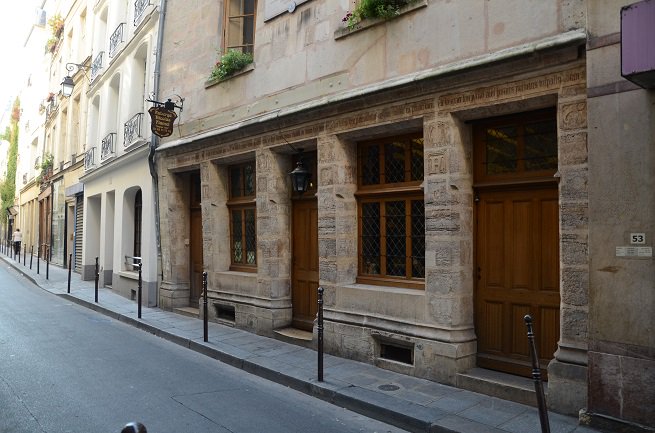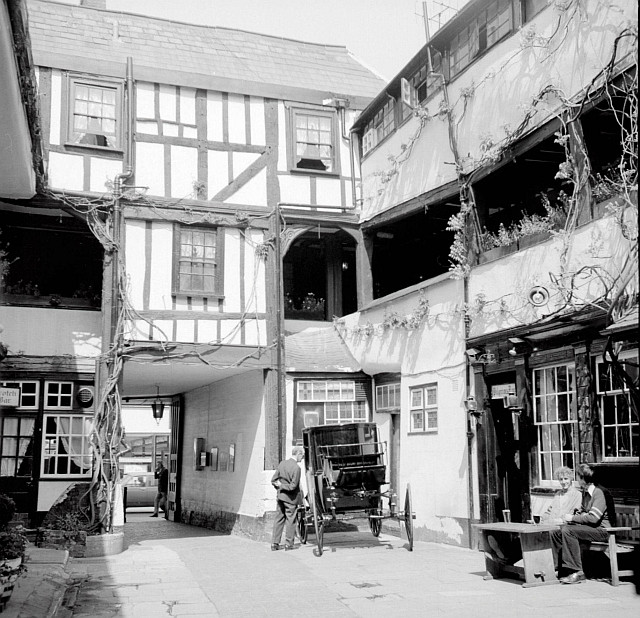SHORT ANSWER
Yes, there were, but information on inns and hostels before around 1300 is patchy at best and the evidence suggests that, for the early middle ages especially, travellers were often given board and lodging by locals, especially those higher up the social hierarchy. After 1300, though, there are an increasing number of references to inns and hostels as well as some physical evidence.
DETAILED ANSWER (this is mostly, but not entirely, chronological and refers to England unless otherwise stated)
Evidence of inns or hostels in Anglo-Saxon England and among the Norsemen is limited. In part, this may be because there were few of them as there was little need in many places (see below). There were fewer travellers than in later times and the custom in Scandinavian and Anglo-Saxon societies was to provide food and lodging for travellers. In Icelandic society at least,
hosts [meaning everyone] were expected to generously welcome and provide food and shelter
for passing travelers…guests were likewise expected to be polite…and
sometimes even reimburse them in the form of goods, services, or
labor.
In Anglo-Saxon England,
hospitality was always a duty, strictly limited and framed by custom.
It may have been provided to a single traveller, to a member of a
formal or informal network (particularly ecclesiastical), to a king or
to his agents
This 'system' of hospitality was, in all likelihood, fairly widespread and dated back many centuries. Tactitus (c. 56 to c. 120 AD), in Germania, writes that:
It is accounted a sin to turn any man away from your door. The host
welcomes his guest with the best meal that his means allow....No
distinction is ever made between acquaintance and stranger as far as
the right to hospitality is concerned.
Source: Tactitus, The Agricola and the Germania (trans: H. Mattingly, revised by S. A. Handford, Penguin Classics, 1970)
Nonetheless, at least some Anglo-Saxons were not unfamiliar with hostels. Clear evidence of hostels in Rome is found in the Anglo-Saxon Chronicle where there are
several references in ninth-century
entries to the “ongelcynnesscole” (“Anglo-Saxon quarter”) in Rome,
where English expatriates and visitors could stay in an English
hostel or worship at an English church.
Although one might expect enterprising individuals to set up inns in areas where there was a demand, this does not appear to have always been the case. In early 12th century Norway, King Eystein I (reigned 1103 to 1123) set up a hostel in Dovre because,
As visitors such as craftspeople and merchants came in increasing
numbers to Bergen, the traditional hospitality that travellers could
normally expect would no longer suffice
A statute of King Edward I of England in 1285 mentions the ownership by foreigners of, among other things, hostels and inns; later, foreigners were barred from owning such establishments along the River Thames in London.
According to John Hare in his book Inns, innkeepers and the society of later medieval England, 1350–1600, inns "were a crucial part of the economic infrastructure of the country". Also, Phillipp R. Schofield, in Peasant and Community in Medieval England, 1200–1500, states
By the close of our period [1500], village inns and hostelries were
establishing themselves as permanent features of the countryside.
This article, which uses Compton Reeves' Pleasures and Pastimes in Medieval England and Life in a Medieval Village by Frances & Joseph Gies as sources, states:
The inn of a town was usually located in a central location such as
the town square, or in places where trade roads met. In France and the
Holy Roman Empire, coach-inns also became important drivers of the
economy – these coach inns were mostly found on big trade routes
between distant locations.
As inns became more common in the 14th century, they began to put up signs (with pictures, for many people were illiterate) as a way of advertising themselves. By the time of Chaucer (died 1400) at least, one could find a wide range people when one walked into an inn or tavern. In addition to adventurers, among them were
foreigners…transient English, unspeakable Scots…a general rabble of
rootless people…. honest peasants and artisans, respectable
merchants…pilgrims, clerics…royal officials, nobles, knights, robbers,
prostitutes, and con men
Unsurprisingly, the physical evidence of these establishments has mostly vanished but there are a few which have survived, at least in part. One such is in Paris, established by Nicolas Flamel (“today immortalized as an alchemist, thanks in part to J.K. Rowlings’ Harry Potter series”) in 1407 as an early charity to cater for itinerant workers.

Exterior of the Auberge Nicolas Flamel
Also in France, another example of a hostel was at Cluny monastery:
Adjoining the gatehouse was a large building that held the stables and
a hostel for travelers, with adjacent latrines.
Source: J.L. Singman, 'Daily Life in Medieval Europe' (1999)
In England, The Angel Inn in Andover (Hampshire, southern England) has been in operation since at least 1456 in the current building (built between 1444 and 1455, although the façade is much more recent). Another example is The New Inn in Gloucester, built in 1450.

A 1973 photograph of The New Inn, Gloucester—the most complete surviving example in Britain of a medieval courtyard inn. Attrib: Alan Longbottom [CC BY-SA 2.0 (https://creativecommons.org/licenses/by-sa/2.0)], via Wikimedia Commons
As to profitability (in the late medieval period at least), this abstract on Hare's book states:
Inns generated substantial rent and were evidently felt to be worth considerable investment. Innkeepers were among the rich and influential members of the town.
As European economies grew, there were increasing numbers merchants who needed a place for the night (business travellers, if you like). Pilgrims were, in some places at least, a source of profit sufficient for local authorities to target for for taxation. In Italy, for example,
At Siena on the Via Francigena in Tuscany, a special levy was
exacted from innkeepers who stood to profit from the flow of pilgrims.
Source: D. Webb, 'Pilgrims and Pilgrimage in the Medieval West' (2001)
Other source
G. J. White, 'The Medieval English Landscape, 1000–1540' (2012)

